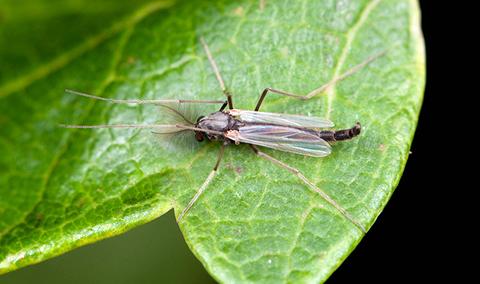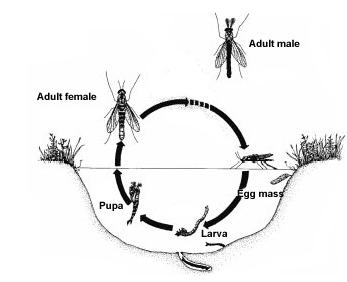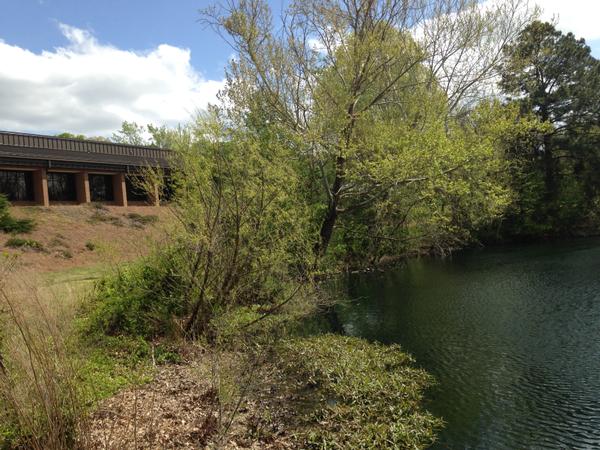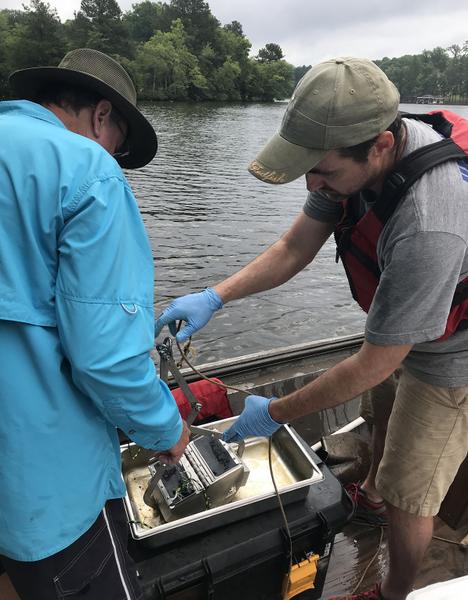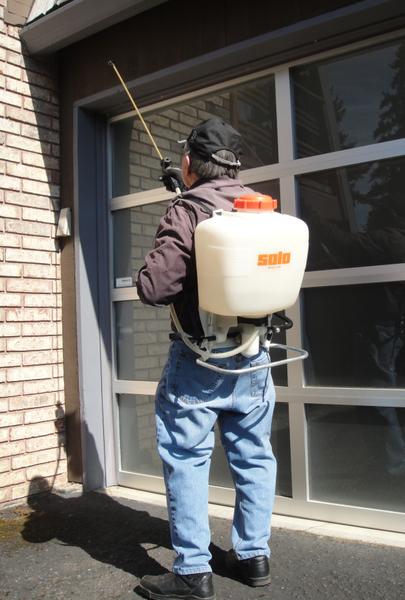Introduction
Non-biting midge flies or chironomids commonly occur in both inland and coastal areas with natural and man-made bodies of water. These midges are commonly known as “blind mosquitoes” because they are mosquito-like in appearance but do not bite. Midges are also called “fuzzy bills” because of the male’s bushy antennae (Figure 1). These aquatic insects are tolerant of a wide range of environmental conditions. Chironomid midges can be found in swift moving streams, deep slow moving rivers, stagnant ditches, and in lakes and ponds that are rich in decomposing organic matter. The presence of certain chironomid midge species is often an indicator of water quality issues.
Bodies of water in urban, suburban and urban areas are subjected to intensive human use through residential, recreational and agricultural activities. Through runoff, these ponds and lakes often become excessively rich in nutrients. Consequently, the variety of organisms found in such habitats is usually low with just a few pollution tolerant species developing large populations. Some species of chironomid midges that are tolerant of low dissolved oxygen conditions are often a major component of the invertebrate populations in urban and suburban lakes, ponds and storm water retention ponds.
Beneficial Aspects and Economic Impacts
Most species of chironomid midges are highly beneficial and desirable organisms in aquatic habitats. Midges are an important food source for fish, shoreline birds and predatory aquatic insects (diving beetles, "waterboatmen", etc.) and bats. Larvae “clean” the aquatic environment by consuming and recycling organic debris.
In residential settings, particularly with homes constructed adjacent to lakes and ponds, adult midges often emerge in very large numbers, causing a variety of nuisance and other problems for people who reside within the flight range of these insects. The adults are weak flyers and may fly or be blown ashore where they congregate on vegetation, under porch alcoves in carports and on walls of homes and other buildings (Figure 2). Swarms of adults may be so dense that they interfere with outdoor activities and stain walls, cars and other surfaces upon which they rest. Adults are attracted to lights and may accumulate in large numbers on window screens and around porch and street lights. Spiders may build web in areas on/near building lights. The unsightly webs may have to be removed frequently.
Midge Life Cycle
Like other flies, chironomid midges have a four-stage life cycle (Figure 3). Females lay eggs on the surface of the water. Each gelatinous egg mass may contain over 1,000 eggs depending on the species. Eggs sink to the bottom where they hatch in several days to one week. After leaving the egg mass, larvae burrow into the mud or construct small tubes in which they live. Larvae enlarge their tubes as they grow. Suspended organic matter in the water and in the mud is used as food by the developing larvae. After they grow, the larvae take on a pink color and gradually turn red. Consequently, mature larvae (Figure 4) are commonly called “blood worms.” The red color results from an iron containing compound, haemoglobin, found in the midge’s blood. The haemoglobin allows the larvae to respire under low dissolved oxygen conditions in the bottom mud. The larval stage can take from 2 to 7 weeks depending on water temperature. Larvae transform into pupae while still in their tubes. After about three days, pupae actively swim to the surface, and adults emerge several hours later. Adults mate in swarms soon after emerging. More recent studies have shown that adult midges actually feed on nectar and other sugary materials. They live for only 3 to 5 days.
During the summer, the entire life cycle from egg to adult can be completed in 2 to 3 weeks. In the fall, larvae do not pupate. They suspend their development and pass through the winter months as mature larvae. Pupation and emergence of adults occur in the following spring in late March or early April. Several more generations of midges are produced throughout summer, resulting in mass emergences of adults that often aggregate on plant foliage near the water’s edge (Figure 5). In each generation, adults will typically emerge in large numbers for several weeks
Breeding Sites
Chironomid midges are one of the most common and most abundant organisms in natural and man-made aquatic habitats. Larvae are found in small and large natural lakes, sewage oxidation and settling ponds, residential lakes and ponds, and slow moving shallow rivers. Densities of over 4,000 larvae/square feet often occur on the bottoms of nutrient rich bodies of water (sometimes an indication of pollution due to excess nutrients). During adult emergence periods, it is not unusual for several thousand adults per square yard of surface to emerge on a nightly basis (Figure 6). Obviously, midges emerging from these bodies of water may cause significant nuisance and other problems by disrupting outdoor activities or clogging air/water filtration systems..
Midge Management Practices
Physical, Mechanical and Cultural Control
Nutrient reduction. Dense larval populations usually occur in nutrient rich habitats. Fertilizer run-off from residential lawns and garden, golf courses and agricultural fields are sometimes responsible for the development of nuisance-level populations of midges. Community awareness and education about proper use of fertilizers can reduce excess run-off into lakes, ponds and streams and can help reduce midge populations. In some instances, it may be helpful to have your pond evaluated and get recommendations for nutrient management.
For information about nutrient reduction practices, see NC State Extension's SoilFacts factsheets.
Winter draw down. Exposing bottom muds by draining ponds and lakes during winter months will kill over wintering midge larvae, reducing the size of the adult population emerging in the following spring. Understandably, this method may not be economically or logistically practical for many bodies of water.
Diversion of adults. Many lakes and reservoirs that experience nuisance populations of midges have homes, businesses and marinas constructed along the shore lines. After emergence, midge adults are attracted to shoreline lights. High intensity white light has been found to be highly attractive to adults. Keep window blinds closed and porch lights turned off during heavy emergence periods to help reduce the number of adults attracted to these areas. Strategically placed high intensity white lights may divert midges away from populated areas.
Electrocutor traps. Electrocutor traps will attract and kill large numbers of midge adults. However, a single trap in a yard is unlikely to kill a sufficient number of midge adults to appreciably reduce nuisance populations. In addition, during heavy adult activity, the trap may malfunction as a result of becoming clogged with midge body fragments.
Lighting Modification. If you live in/near a lakeside community or near a pond, you might try getting advice from your local government or electrical utility or a lighting consultant concerning the type of outdoor public lighting in your neighborhood. Some research has shown that LED lights are less attractive to midges and other night-flying insects as compared to metal halide and fluorescent lighting. There may be a situation where you would use brighter lights in an non-occupied area to attract them away from houses or where people are active outdoors. With residential structures, reducing exterior night-time lighting can help (as long as it doesn't compromise safety concerns). Close window shades to limit light shining through windows. Use subdued walkway/landscape type lighting if you wish. Avoid using floodlights except when needed.
Biological
A large variety of aquatic organisms feed on midge larvae including dragonfly naiads (nymphs), predaceous diving beetles and a variety of fish species. Where the diversity of predaceous animals is high, the density of midge larvae is usually held below nuisance population levels. Shallow, organically rich lakes and heavily polluted habitats such as sewage waste lagoons are inhabited by fewer predaceous species compared to bodies of water that receive less nutrient-rich input.
Predatory fish. Chironomid midges are a major component of the diet of many fish species. In particular, bottom-feeding fishes, such as catfish and carp, consume large numbers of midge larvae. However, the feeding habits of these fish has generally not been shown to reduce adult midge populations below nuisance levels adjacent to habitats with large larval populations. You might want to contact your local NC Wildlife Resources Commission office for advice on stocking ponds.
Insecticidal Control
Larvicides. Larvicides are insecticides that target the midge larvae. In fact, most of the common midge larvicides se products are effective strictly against the larvae. For example, the insect growth regulator (“IGR”) S-methoprene (or Strike®) is registered for use in municipal wastewater treatment facilities to control midges and filter flies. IGRs are only effective against immature insects. The biological larvicide, Bacillus thuringiensis var. israelensis (Bti) is sold under several brand names and contains a protein toxin that affects midge and mosquito larvae as well as the larvae of a few other Diptera such as fungus gnats. Bti is only toxic after it is consumed by the midge larvae. Consequently, high organic content in water presents a competing food source for the midges and can reduce the pesticide’s effectiveness against midges. Bti is only effective at high rates of application (at least 10 times the rates needed for mosquitoes), which can limit the economic use of Bti to small habitats. Insecticide formulation is also important. Because midge larvae are typically found in the sediment and lower strata (levels) of the water, pellet formulations Bti and S-methoprene provide the best results because they sink quickly to the bottom and release the larva-killing protein into the midge feeding zone (Gray et al. 2011).
In order for the treatment to be effective, you need to time your applications properly. Accordingly, dredge samples of bottom mud should be collected, sieved, and the chironomid larvae recovered and counted (Figure 7). Chemical treatments should be made when the number of larvae exceeds 100 per 6-inch square bottom sample. This treatment threshold is completely arbitrary and based on insecticide treatments made for the control of midge larvae in Florida and California. Without monitoring a midge population for one season, the relationship between numbers of immature midges found in the bottom mud and the subsequent numbers of nuisance adults cannot be established.
Research has shown midge populations are often highest in the shallower edges of ponds. Treating a 20-foot wide band along the shoreline can be as effective (and less expensive) than trying to treat the entire pond (Gray et al. 2011).
Adulticides. Many insecticides that are registered for control of the adult midges are the same products used for mosquitoes. These products are listed in the North Carolina Agricultural Chemicals Manual. Adulticides can be applied in the air as ultra low volume sprays but are more commonly applied as diluted sprays to wall surfaces or vegetation where midge adults rest. The use of insecticides against adults should be expected to achieve temporary control during heavy emergence periods, because treated areas are rapidly repopulated by midges flying in from outside the treatment zone. Application of residual insecticides to porch alcoves, carports, under the eaves of house and other similar areas (Figure 8) should help to discourage the establishment of spiders that are associated with outbreaks of chironomid midge adults. Be careful when spraying vertical surfaces over impervious surfaces such as driveways, patios, etc. In these situations, broadcast sprays over wide exposed surfaces can lead to run-off into storm drains.
References
Ali, A. and C. D. Morris. 1992. Management of non-biting aquatic midges. IFAS, Univ. of Florida Medical Entomology Laboratory Technical Bulletin no. 4. 16 p.
Gray, Elmer W., R. A. Fusco, C. Royals., R. Noblet, and R. D. Wyatt. 2011. Field Evaluation of Bactimos PT against chironomid midge (Diptera: Chrionomidae) larvae in resisdential ponds. J. Am. Mosq. Control Assoc. 27(2): 173-176.
Koehler, P. 1980. Extension Entomology Report #62. IFAS, Univ. of Florida, Florida Cooperative Extension Service Plant Protection Pointers. 6 p.
Zemet, R.S. and D. Houghton 2017. The Ability of Specific-wavelength LED Lights to Attract Night-flying Insects, The Great Lakes Entomologist, vol 50 (2).
Publication date: July 1, 2018
Reviewed/Revised: June 30, 2019
Recommendations for the use of agricultural chemicals are included in this publication as a convenience to the reader. The use of brand names and any mention or listing of commercial products or services in this publication does not imply endorsement by NC State University or N.C. A&T State University nor discrimination against similar products or services not mentioned. Individuals who use agricultural chemicals are responsible for ensuring that the intended use complies with current regulations and conforms to the product label. Be sure to obtain current information about usage regulations and examine a current product label before applying any chemical. For assistance, contact your local N.C. Cooperative Extension county center.
N.C. Cooperative Extension prohibits discrimination and harassment regardless of age, color, disability, family and marital status, gender identity, national origin, political beliefs, race, religion, sex (including pregnancy), sexual orientation and veteran status.

